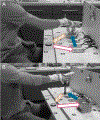Grasp Posture Variability Leads to Greater Ipsilateral Sensorimotor Beta Activation During Simulated Prosthesis Use
- PMID: 39041372
- PMCID: PMC11343659
- DOI: 10.1080/00222895.2024.2364657
Grasp Posture Variability Leads to Greater Ipsilateral Sensorimotor Beta Activation During Simulated Prosthesis Use
Abstract
Motor behaviour using upper-extremity prostheses of different levels is greatly variable, leading to challenges interpreting ideal rehabilitation strategies. Elucidating the underlying neural control mechanisms driving variability benefits our understanding of adaptation after limb loss. In this follow-up study, non-amputated participants completed simple and complex reach-to-grasp motor tasks using a body-powered transradial or partial-hand prosthesis simulator. We hypothesised that under complex task constraints, individuals employing variable grasp postures will show greater sensorimotor beta activation compared to individuals relying on uniform grasping, and activation will occur later in variable compared to uniform graspers. In the simple task, partial-hand variable and transradial users showed increased neural activation from the early to late phase of the reach, predominantly in the hemisphere ipsilateral to device use. In the complex task, only partial-hand variable graspers showed a significant increase in neural activation of the sensorimotor cortex from the early to the late phase of the reach. These results suggest that grasp variability may be a crucial component in the mechanism of neural adaptation to prosthesis use, and may be mediated by device level and task complexity, with implications for rehabilitation after amputation.
Keywords: amputation; electrophysiology; rehabilitation; upper limb.
Conflict of interest statement
Declaration of interests
The authors report no conflict of interest. This work was supported by the National Institutes of Health under Grant 1R03NS103006-01.
Figures






Similar articles
-
Evaluating self-assistance during functional reach with a passive hydrostatic exoskeleton under artificial impairment.J Neuroeng Rehabil. 2025 Jul 16;22(1):163. doi: 10.1186/s12984-025-01696-8. J Neuroeng Rehabil. 2025. PMID: 40665370 Free PMC article.
-
Interventions for motor rehabilitation in people with transtibial amputation due to peripheral arterial disease or diabetes.Cochrane Database Syst Rev. 2023 Jun 5;6(6):CD013711. doi: 10.1002/14651858.CD013711.pub2. Cochrane Database Syst Rev. 2023. PMID: 37276273 Free PMC article.
-
What Are the Factors Associated With Revision Surgery on the Residual Limb and Functional Results in Patients With Posttraumatic Lower Limb Amputations?Clin Orthop Relat Res. 2025 Mar 1;483(3):501-510. doi: 10.1097/CORR.0000000000003251. Epub 2024 Sep 19. Clin Orthop Relat Res. 2025. PMID: 39453607
-
Bioengineered nerve conduits and wraps for peripheral nerve repair of the upper limb.Cochrane Database Syst Rev. 2022 Dec 7;12(12):CD012574. doi: 10.1002/14651858.CD012574.pub2. Cochrane Database Syst Rev. 2022. PMID: 36477774 Free PMC article.
-
How To Improve Patient Selection in Individuals With Lower Extremity Amputation Using a Bone-anchored Prosthesis.Clin Orthop Relat Res. 2025 Jun 1;483(6):1075-1092. doi: 10.1097/CORR.0000000000003369. Epub 2025 Jan 24. Clin Orthop Relat Res. 2025. PMID: 39853312
References
-
- Alterman BL, Keeton E, Ali S, Binkley K, Hendrix W, Lee PJ, Wang S, Kling J, Johnson JT, & Wheaton LA (2022). Partial-hand prosthesis users show improved reach-to-grasp behaviour compared to transradial prosthesis users with increased task complexity. Journal of motor behavior, 54(6), 706–718. 10.1080/00222895.2022.2070122 - DOI - PMC - PubMed
-
- Bayani KY, Lawson RR, Levinson L, Mitchell S, Atawala N, Otwell M, Rickerson B, & Wheaton LA (2019). Implicit development of gaze strategies support motor improvements during action encoding training of prosthesis use. Neuropsychologia, 127, 75–83. 10.1016/j.neuropsychologia.2019.02.015 - DOI - PMC - PubMed
MeSH terms
Grants and funding
LinkOut - more resources
Full Text Sources
Other Literature Sources
Medical
